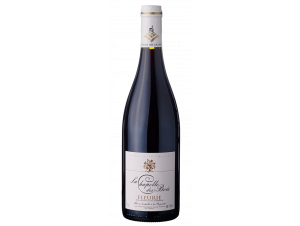You have no items in your shopping cart.
Wine Fleurie
The AOC Fleurie is one of the ten crus of the Beaujolais. Renowned since the 18th century, the vineyard covers 870 hectares, at an altitude of between 220 and 430 metres, on sometimes very steep slopes. Fleurie produces an annual average of 4,500 hectolitres of a red wine much appreciated for its finesse. Read more on Fleurie
-
Top Selling-25%
-
Top Selling-21%
-
Top Selling-22%
- -20%
- -27%
- -17%
- -20%
- -18%
- -14%
Appellation Fleurie
The Gamay of Fleurie
The commune of Fleurie owes its name to a Roman soldier, Florus, who is said to have been present in ancient times and to have been the origin of the village.
The Fleurie estate is bordered to the south by the Morgon, to the west by the Chiroubles and to the north by the windmill. The vines are most often south-east or north-west facing. The Beaujolais mountains to the west shelter it from the wind and the area benefits from the influence of three climates: continental, Mediterranean and oceanic, which is perfect for the Gamay grape.
The soil is light with sand from the disintegration of pink granite. It can also be deeper and clayey. This gives a very fine production which makes the AOC Fleurie considered as the most feminine of the Beaujolais crus.
In this region, the term "climats" is used to refer to a delimited geographical denomination constituting one or more appellations, similar to a vineyard. Fleurie covers 13 climats, the most famous of which are Champagne, Les Moriers, La Chapelle des Bois, La Roilette and La Madone. You can therefore find wines whose appellation is Fleurie, followed by one of these thirteen names of climates.
Gamay has a dominant aroma that immediately brings to mind red fruits. The floral notes are also powerful and you can recognize violet, iris or rose. The wines are very fine, but when they come from the plots where the soil is more clayey, they become more robust. They are always harmonious and can be used as wines for laying down.
The delights of AOC Fleurie
The colour of Fleurie is an intense vermilion red that can have pale mauve highlights. This colour is due to the presence of granite. As the wine matures, its colour changes to ruby or carmine. It is darker if the wine comes from deep soil and brighter if it comes from the slopes where the soil is lighter.
The nose of Fleurie is marked by red and black fruits, such as cherry, blackcurrant, blackberry and raspberry. In addition to the flowers already mentioned, violet, iris or rose, you can find hints of peony. The most typical climate of Fleurie is the Grille-Midi, recognisable among all with aromas of black fruits such as blackberry.
Fleurie's palate is frank and lively at first. It then becomes rounder and delights you with low acidity and very fine tannins. It is never aggressive and its perfumes delicately coat your palate.
The wine is best drunk at 14°C. It can be served as an aperitif with a goose terrine, pork fritons or quail or pork terrine.
For the starter, you can propose Beaujolais soup, bouchées à la reine, oeufs en meurette, poultry liver pie or sausages in brioche. For the main course, your Beaujolais La Fleurie will be perfect with carp fillets with Régnié, eel matelotes from the Rhône, andouillette beaujolaise, rabbit à la beaujolaise or hot sausage with Beaujolais.
Beaujolais et Lyonnais appellations

































 TWIL - Achat de Vin
TWIL - Achat de Vin


